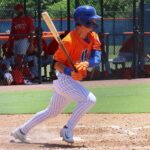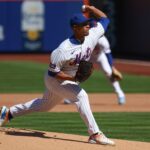
Corey Oswalt was pressed into service as the Mets’ starting pitcher Tuesday night in Miami, after David Peterson was placed on the injured list with fatigue in his left shoulder. Oswalt tossed 4.1 innings, allowing two runs on five hits, striking out four and walking none.
Oswalt threw 74 pitches, 44 of which were strikes. The 26-year-old did a nice job of keeping the Marlins’ hitters off balance, primarily featuring a change up with good late sink.
Oswalt began his night by allowing a hit to Miami’s leadoff hitter, Jonathan Villar. He then picked Villar off first base, before proceeding to retire nine Marlins in a row. In the meantime, his Mets teammates staked him to a 3-0 lead, which shrank to a 3-2 lead when Oswalt surrendered two runs in the bottom of the fourth inning.
All things considered, Oswalt probably over-delivered on expectations. First, Peterson was set to start until Tuesday, when he reported discomfort in his shoulder, a condition to which he alluded to after his start against Washington on August 13th at Citi Field.
Second, Oswalt has not been good in his major league appearances thus far in his career. Entering action on Tuesday night, he had an ERA of 6.69 and a FIP of 6.10 over parts of three seasons with the Mets. Last year at Syracuse, Oswalt showed some promise, posting a 10-4 record with a 2.91 ERA and a 3.74 FIP.
The key question for Oswalt and the Mets is what will happen from this point. Oswalt has likely earned another start with Peterson on the 10-day IL. If Peterson misses just two starts, Oswalt may have the chance to pitch his way onto the roster in a relief or spot starting role, with the uncertainty around Michael Wacha‘s health and Steven Matz‘s effectiveness.
With the season close to half over, it’s hard to imagine that the Mets’ rotation is currently comprised of Jacob deGrom, Steven Matz, Rick Porcello, Robert Gsellman, and Corey Oswalt.
In this shortened season, anything is possible and strange things will happen. A look at the Mets’ rotation can serve to confirm this theory.
















